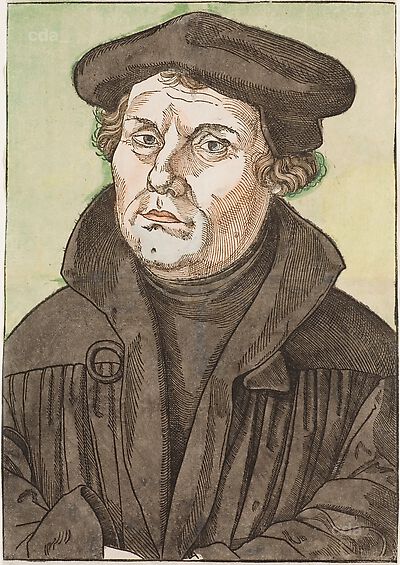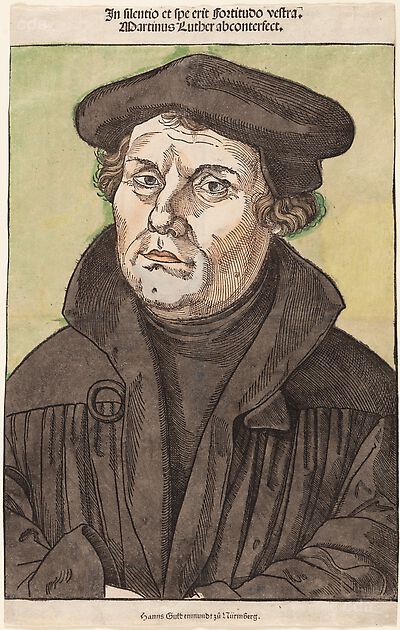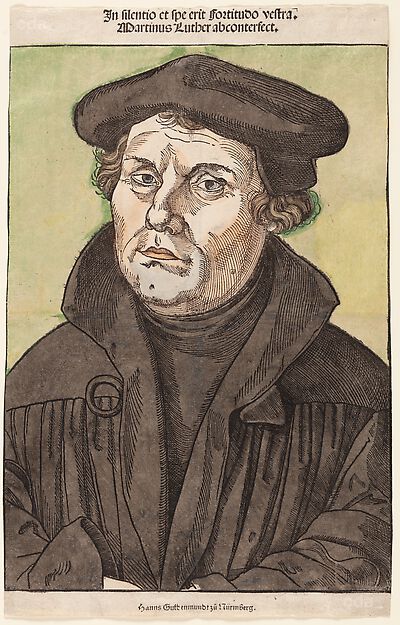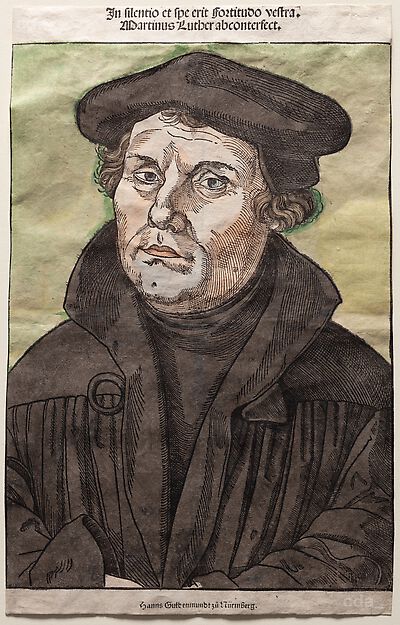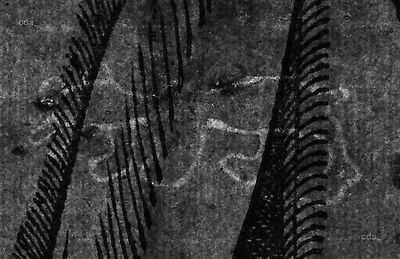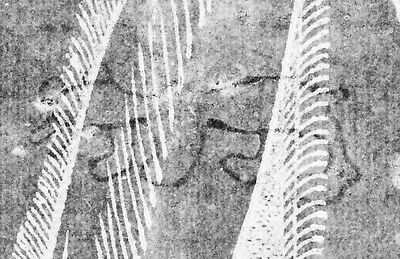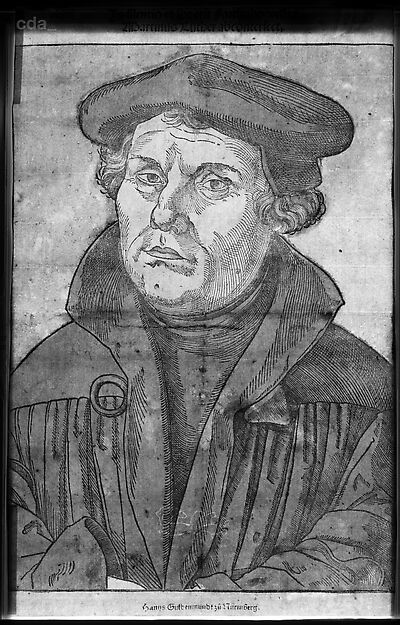Only one impression of this woodcut is known to have survived[1] and until now it has been interpreted as a direct adaptation from a painted Luther portrait that was mass-produced by Lucas Cranach the Elder and his workshop (IV.M1–IV.M24) from 1528.[2]
However, a systematic comparison with other surviving Luther portraits
Only one impression of this woodcut is known to have survived[1] and until now it has been interpreted as a direct adaptation from a painted Luther portrait that was mass-produced by Lucas Cranach the Elder and his workshop (IV.M1–IV.M24) from 1528.[2]
However, a systematic comparison with other surviving Luther portraits shows that the woodcut is directly related to a painting of Luther from 1533 signed by Georg Pencz, which, for its part, relies on the Cranach prototypes.[3] A detailed comparison shows that the contours and the features of the face in the woodcut correspond exactly with those of the Pencz painting, evident even in the smallest detail, like the reflection of the window transoms in Luther’s eyes.[4] Lines executed with a dry drawing material defining the eyes, nose, mouth and wrinkles are visible in the painting’s underdrawing.[5] Areas of shadow in the face are rendered with close parallel hatching strokes that fan out around the nostrils. In the painted version the bridge of the nose is straighter in comparison with the underdrawing. However, the woodcut exhibits the underdrawing’s rounder nose bridge and also shows considerable similarities in the wrinkles under the eyes and the fan-shaped shading around the nose. This is particularly apparent in the tuft of hair covering Luther’s right ear. In the underdrawing it is broader than in the final painted version. The woodcut however shows an additional lock of single hair strands that is also present in the underdrawing. It is evident that the woodcut includes distinct elements that only appear in this form and arrangement in the underdrawing and not in the final painted version.
This, coupled with the fact that the painting and the woodcut are of the same size, suggests that a common preparatory sketch existed for both. Very fine pale lines visible at the centre of the raised areas of the printing block (particularly in the face), originate from a drawing that was used to transfer the design to the block. Especially in view of the pronounced stylistic similarities between the underdrawing of the painting and the lines of the woodcut the question of authorship must be re-evaluated.
Initially Max Geisberg’s arbitrary attribution in 1930 to Hans Brosamer was not challenged.[6] The New Hollstein-Band is the first to list the sheet among the „doubtful attributions“.[7] Here for the first time an attribution to Pencz is proposed, based on the similarities, described above, with the underdrawing of the painting signed by Georg Pencz.
Records show that Pencz, just like Brosamer, worked for the printmaker and illustrator Hanns Guldenmundt[8], who can be identified by the type face of the Subscriptio as the publisher of this sheet.[9] In the Superscripto, which is also typeset, Guldenmundt identifies the sitter using the Luther motto found inscribed on Cranach’s paintings from 1529.[10] This motto is also present on Pencz‘[11] engraving of Luther from 1530 (IV.D2a), which despite the different technique and dimensions shows clear similarities with this print. These include not only a similar distribution of cross and parallel hatching strokes, but also features like the prominent hump on the nose or the accentuated bulge of the brow around the temples.
Signed works testify that at the beginning of the 1530s Georg Pencz explored the subject of Luther’s portrait in both engraving and painting. It would therefore seem reasonable to date this woodcut attributed to Pencz between about 1530 and 1532.[12] [13] The paper used for this impression was acquired by the publisher and printmaker Guldenmundt rather than by Pencz himself and exhibits a watermark with a ‚striding bear’, that was first used by papermakers in Bern from about 1465. However, since 1520 (until about 1580) it was copied by paper mills in Lothringen, Basel, Kempten (Allgäu), Reutlingen and Strasbourg.[14]
Two states of this woodcut are known to research.[15] Geisberg presents the reproduction of a slightly different impression from the Princely Collections, Liechtenstein. The provenance of the present example can be traced back to the Liechtenstein collection, suggesting that the reproduction in Geisberg could be an poor reproduction of the only existing impression that is discussed in this article.[16] The sheet was acquired as part of a larger collection from the Prince of Liechtenstein in 1953 by Colnaghi in London[17] and was auctioned in 1961 by Klipstein & Kornfeld in Bern.[18] Once again at Kornfeld’s, the sheet was put up for sale in 2000[19] when it was bought by the present owner.
[1] Minneapolis, Thrivent Collection of Religious Art, Inv. no. 01-02, Sheet: 359 x 254 mm. Regarding the problem of the number of surviving impressions see below. The impression is hand coloured with the gown and cap painted in a uniform brownish-black colour, in the area of the face pale flesh paint was used, the cheeks, lips and areas of shadow were emphasized with pale red, as well as the bluish grey hint of a beard. The background is now a delicate green with a bolder paint application around the hair and the cap.
[2] Most recently in Exhib. Cat. Minneapolis/New York/Atlanta 2016, no. 233.
[3] See Dyballa 2014, B 2, pp. 266–268 with further literature. The relationship to the Cranach prototypes that correspond to Portrait Group IV. is also discussed.
[4] In contrast comparisons with possible Cranach prototypes from Portrait Group IV show considerably less correlation of facial contours and features.
[5] See Dyballa 2014, p. 268
[6] See Geisberg 1930, no. 425.
[7] Only an extremely small quantity of the large number of graphic works attributed to Brosamer are signed. This makes a stylistic attribution difficult, as does the fact that over the course of his career Brosamer worked in different locations and for printmakers throughout the empire, which meant that his designs were executed by different form-cutters. See Knauer 2015 with regard to this problem. We would like to thank Martin Knauer for his contribution on this subject.
[8] On Guldenmundt, see Timann 1993.
[9] Such as the pamphlet „Der Falsche klaffer“, see Röttinger 1914, no. 36.
[11] For a discussion about the identification of the Monogrammist IB with Georg Pencz see the classification of IV.D2.
[12] Between the end of 1532 and the 7 January 1534 Guldenmundt was banished from the town because of allegations of bigamy. Therefore he could not have provided the print. See Timann 1993, pp. 160–161.
[13] Auct. Cat. Bern 2000, lot 22 dated “about 1540”, Exhib. Cat. Minneapolis/New York/Atlanta 2016, no. 233 dated “about 1530–1540”.
[14] See Piccard 1987, p. 7.
[15] Such as in the Auct.-Cat. Bern 1961, lot 35. The illustration in Geisberg 1930, no. 425, which is also published in the Hollstein- and New Hollstein-Bands, does not show any evidence of the hand colouring and deviates slightly from this sheet in detail, like the outer lock of hair.
[16] As has been demonstrated elsewhere Geisberg’s reproductions cannot be used as proof, as they often do not reproduce the finer detail of the referenced original with enough accuracy.
[17] Colnaghi Archive, Prince of Liechtenstein Print Collection Stock Book No. 4, Sig. COL3/4/4, Nr. 330.
[18] Auct.-Cat. Bern 1961, lot 35.
[19] Auct.-Cat. Bern 2000, lot 22. Here also the Prince of Liechtenstein is unanimously considered to be the former owner of this sheet.
- Attributions
-
Georg Pencz, Inventor*in
Hans Brosamer (?), Inventor*in
Attributions
| Georg Pencz, Inventor*in | [KKL 2022] |
| Hans Brosamer (?), Inventor*in | [Hollstein German IV.595.259] |
| Hans Brosamer, Inventor*in | [Geisberg 1930, No. 425] |
| Hans Guldenmund, printer | [KKL 2022] |
- Production date
- about 1530-1532
Production date
| about 1530-1532 | [KKL 2022] |
- Dimensions
- Sheet:
Dimensions
Sheet:
Image: 357 x 252/249 mm [Dakota Passariello, Thrivent Art Collection Minneapolis, 2021]
- Signature / Dating
None
- CDA ID
- HB_HIV-259-595
- KKL-No
- IV.D1, Part of portait group IV
- Persistent Link
- https://lucascranach.org/en/HB_HIV-259-595/
